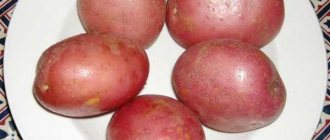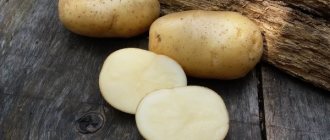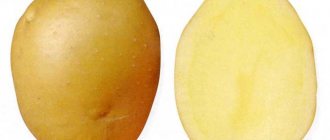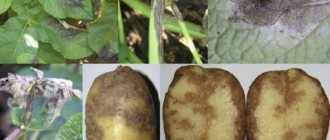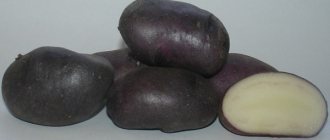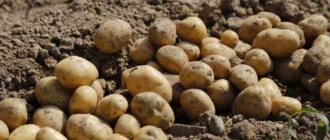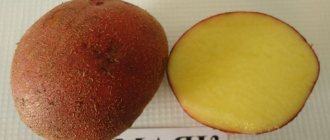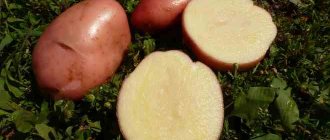Vegetable growing » Potatoes
0
1126
Article rating
Kira Stoletova
The Lilac Fog potato is a mid-season variety. It is grown by farmers on their plots for further sale. It can also be grown for the farmer's own consumption. This is a table variety, but is not recommended for use in making chips. Due to the fact that it has excellent commercial qualities, it can be sold profitably.
Description of the Lilac Fog potato
Origin
A variety of Russian selection, included in the State Register of the Russian Federation in 2011. Originator: Primorsky Research Institute of Agriculture.
Zoned for the North-Western and Far Eastern regions. Potatoes are recommended for growing in private household plots, on farms, and can be planted in industrial areas. Large tubers of equal weight and size are ideal for sale.
The tubers are not damaged when digging and are stored for a long time . The seed material does not degenerate; it can be collected in your own fields for several years in a row.
Potatoes “Lilac Fog”: description of the variety
| Variety name | Purple Haze |
| general characteristics | is characterized by increased resistance to degeneration |
| Maturation period | 90-110 days |
| Starch content | 14,4-17,2% |
| Weight of marketable tubers | 90-160 |
| Number of tubers in a bush | 7-10 |
| Productivity | 182-309 (maximum 495) |
| Consumer qualities | good taste and cooking ability, suitable for preparing any dishes |
| Keeping quality | 98% |
| Peel color | pink |
| Flesh color | light yellow |
| Preferred Growing Regions | Northwestern, Far Eastern |
| Disease resistance | susceptible to golden potato cyst nematode, moderately resistant to late blight pathogen of tops and tubers |
| Features of cultivation | does not tolerate heat well |
| Originator | North-Western Research Institute of Agriculture (St. Petersburg, Russia) |
The variety belongs to the mid-season table variety. The yield is high; depending on climatic conditions and the nutritional value of the soil, from 182 to 309 centners of selected potatoes can be harvested from 1 hectare. The maximum yield was recorded at 495 centners per hectare .
You can compare the yield of Lilac Fog with other varieties based on the table data:
| Variety name | Productivity |
| Purple Haze | 182-309 c/ha |
| Margarita | 300-400 c/ha |
| Aladdin | 450-500 c/ha |
| Courage | 160-430 c/ha |
| Beauty | 400-450 c/ha |
| Grenada | 600 c/ha |
| Mistress | 180-380 c/ha |
| Vector | 670 c/ha |
| Mozart | 200-330 c/ha |
| Sifra | 180-400 c/ha |
Harvested potatoes are stored for a long time without losing their commercial qualities. The keeping quality of tubers reaches 98%. Long-distance transportation is possible.
The main thing for preserving the harvest is creating the right storage conditions. Read more about storing potatoes in winter, on the balcony and in boxes, in the refrigerator and peeled. And also about temperature and timing, about possible problems.
Bush of intermediate type, tall or very tall, with moderately spreading branches and abundant formation of green mass. The leaves are large, dark green, with slightly wavy edges. The corollas are large, collected from pink-violet, quickly falling flowers. Berry production is low. The root system is powerful, 10-15 large potatoes are formed under each bush . The amount of non-commodity items is minimal.
In the table below you will find indicators of the main important characteristics of other potato varieties for comparison with Lilac Fog:
| Variety name | Weight of marketable tubers (grams) | Keeping quality |
| Purple Haze | 90-160 | 98% |
| League | 90-125 | 93% |
| Milena | 90-100 | 95% |
| Elmundo | 100-135 | 97% |
| Serpanok | 85-145 | 94% |
| Svitanok Kyiv | 90-120 | 95% |
| Sheri | 100-160 | 91% |
| Bryansk delicacy | 75-120 | 94% |
The variety is resistant to many dangerous nightshade diseases: potato blight, leaf roll virus. Susceptibility to late blight, banded and wrinkled mosaic is average. Infection with golden cyst nematode is possible.
Rootstock grape varieties
"Richter 57"
Richter 57
The flower is feminine in its functions. The clusters are small, loose, and the berries are dark in color. The variety is frost-resistant and resistant to fungal diseases. Excellent phylloxera resistance. The variety exhibits resistance to active lime in the soil up to 17%. Tolerates dry periods. Most often used for selection.
The bushes grow medium. Upright shoots with a brown monochromatic vine. Internodes reach 14 cm in length. Moderate development of stepchildren. High yield - 180-210 thousand cuttings per hectare.
"Baytur"
In Michurinsk, the harvest ripens by the beginning of October. The plant has powerful, medium-sized bushes. The shoots have excellent ripening properties. The flower is bisexual, the growth of the bushes is strong. The clusters are small, branched, and cylindrical in shape. The berries are oval or slightly rounded, black with a rich waxy coating and colored juice. The pulp is slightly juicy and slimy.
During the ripening years, sugar content reaches 12%-17%, and acidity – 22-28 g/l. The plant has large foliage, round in shape. Each leaf is practically solid, three-lobed. The cuttings take root well. The variety has average yields. Often used in the production of juices and wines, as well as for decorative purposes. Immunity to mildew.
"Clinton"
Synonyms: Plant des Carmes, Worthington, Plant Pouzin
A vigorous plant that produces numerous harvests. The berries on ripe clusters are dark purple (or black), the seeds are large, the acidity is high, the taste is hybrid.
Kolkhozny
A mid-season grape variety that is characterized by strong winter hardiness. Large, rounded leaves (sometimes ovoid), three-lobed or five-lobed. They are slightly dissected, dark green in color, and have slight bristly pubescence below. Open petiole recess, wide, vaulted, bottom round or flat.
The flower of this variety is functionally female. Small, cylindrical clusters ripen, with a slightly loose surface. The berries are small, black, round. The skin of the berries is thick, with a strong waxy coating. Surprisingly juicy pulp. The ripening period is 131 days. The yield per hectare reaches 60 centners. The plant is not susceptible to mildew. Most often used in breeding work and for decorative purposes.
Gravesak
Medium-sized, powerful bushes that take root in moderately drained, insufficiently fertile soils. Tolerates acidic soils and is resistant to chlorosis. Also, the variety easily survives dry times.
Advantages and disadvantages
Among the main advantages of the Lilac Fog potato variety are::
- good taste of tubers;
- high productivity;
- collected root crops are well stored and can be transported;
- unpretentiousness;
- drought resistance;
- The tubers have excellent commercial quality.
Disadvantages include susceptibility to certain diseases and pests . Potatoes prefer fertile soils; in poor, heavy soil the yield is significantly reduced.
Characteristics
- large tubers, weighing from 90 to 160 g;
- round-oval shape;
- the tubers are smooth and neat;
- the peel is red, evenly colored, moderately thin, smooth;
- ocelli superficial, shallow, few in number;
- the pulp is light yellow when cut;
- the starch content is high, ranging from 14.4 to 17.2%;
- high content of protein, vitamins, valuable amino acids, beta-carotene.
The taste of potatoes is very pleasant: rich, not watery, tender.
Due to their high starch content, the tubers are crumbly, ideal for making purees.
Potatoes can be baked, stewed, or used to prepare fillings. Not suitable for deep frying.
Features of cultivation
The agricultural technology of this variety is standard. Planting is carried out in the second half of May, the soil must warm up completely. The first tubers can be dug up in mid-summer, but the bushes show maximum productivity at the end of the growing season.
Potatoes love light, fertile soil . Periodic watering and one-time fertilizing are recommended. Read more about what to feed potatoes, when and how to apply fertilizers, and how to do it correctly when planting.
It is important to carefully hill up the plantings, forming high ridges and removing weeds. Mulching between rows will help in the fight against weeds.
The Lilac Fog potato variety is planted in the second half of May, in completely warmed soil. Before planting, root crops are treated and treated with growth stimulants. The potatoes are then germinated in the light or in damp sawdust.
Important: Cutting the tubers before planting is not recommended; whole-planting significantly increases the yield.
Phacelia
The soil is carefully loosened, humus mixed with wood ash is laid out in the holes.
The bushes need to be placed at a distance of 35-40 cm from each other; row spacing is required with a width of 60-70 cm. Every 2-3 years, the planting areas need to be changed to avoid infection of the tubers and not to reduce the yield. The best predecessors for potatoes are lupine, meadow grasses, oilseed radish, legumes or cabbage. The vacated fields can be sown with fast-growing phacelia, which enriches the soil with useful microelements.
In moderately hot summers, it is recommended to water the plantings 1-2 times. In regions with drier climates, more frequent watering is necessary. The variety can easily tolerate short-term decreases in humidity, but a constant lack of water causes the tubers to shrink.
When growing potatoes, do not forget about spraying with different means. Read in our articles everything about fungicides, insecticides and herbicides, their benefits and harms, and proper use.
During the season, a single feeding with superphosphate or diluted mullein is possible. You cannot overfeed the plants, as this promotes the accumulation of nitrates in the root crops. It is necessary to hill the plantings 2-3 times, forming high ridges. At the same time, weeds are destroyed.
A week before harvesting, the tops are removed from the potatoes, this will help the tubers accumulate maximum nutrients. The collected potatoes are dried on the boundary or under a canopy, sorted, and then put away for storage.
Tip: Tubers intended for sale can be packed directly in the field. Seed material is selected from the strongest, non-diseased bushes. Seed potatoes are sorted and stored separately.
There are many ways to grow potatoes. On our website you will find detailed information about modern Dutch technologies and getting a good harvest without weeding and hilling, learn how to properly grow early varieties and apply methods under straw, in bags, in barrels, in boxes.
Landing rules
In order to grow Lilac Mist potatoes, standard agrotechnical practices are required:
- compliance with crop rotation, in which potatoes should be planted after legumes, green manure, zucchini or onions;
- Medium-sized tubers are selected for planting;
- the seed is treated with a growth stimulator;
- plant on time, in moist, loose, heated soil;
- do not allow thickening of plantings;
- Weeding, loosening the soil, hilling and fertilizing of potatoes are periodically carried out.
Recommended timing
The timing of planting potatoes is not clearly defined. It is necessary to plant tubers in the ground when the soil warms up, but remains moist. Early planting in cold and damp soil will lead to rotting of the planting material, poor germination, and the possibility of damage to plants by return frosts. In warm but dry soil they develop poorly and the yield may be low. Most often this period occurs at the end of April - beginning of May.
Important! It should be remembered that the optimal condition for planting potatoes is when the soil temperature at a depth of about 15 cm is +8 ⁰C.
In the southern regions, the Lilac Fog variety is planted at the end of March, in the Moscow region - at the end of April, in the western regions - at the beginning of May, in Siberia and the Urals - in the second decade.
Soil preparation
To prepare the soil for planting Lilac Fog potatoes, it is necessary to perform a number of operations:
- in autumn, remove plant debris and weeds from the site;
- dig up the soil on the bayonet of a shovel;
- in the spring, add peat humus to the site (about 10 kg per 1 sq. m);
- in case of high acidity, carry out liming;
- loosen the soil without turning the layer;
- clay soil should be treated twice;
- Level the area using a rake.
How to plant correctly
After preparing the soil, you should begin planting Lilac Mist potatoes if the climatic conditions fully meet the required ones.
Fertilizer is applied during digging or directly into each hole. For this purpose, organic or mineral fertilizers are used. They are scattered in such a way that there is no contact with the tuber.
Potatoes should be placed at a depth of no more than 8 cm. Deep planting ultimately leads to an abundance of tops and small tubers. The Lilac Fog variety needs space to grow, so a gap of more than 30 cm is left between the holes, and 70 cm between the rows. The holes can be arranged linearly or in a checkerboard pattern, which helps to ventilate the bushes and reduce the risk of fungal diseases.
Important! Before planting, the tubers can be treated with a growth stimulator and germinate in raw sawdust.
Diseases and pests
Striped mosaic
The variety is resistant to potato cancer, wrinkled and striped mosaic, and various viruses.
For prevention, tubers are pickled before planting, the soil is thoroughly loosened, removing plant remains from it. During the period of late blight epidemic, it is useful to treat plantings with copper-containing preparations. Adding wood ash to the soil helps prevent root rot and blackleg .
Tomato care
To protect against diseases, tomatoes are treated with Abiga-pik 2 weeks after planting. It is imperative to pinch the tops, leaving 2 leaves above the brush - this will allow all the tomatoes to plump and ripen.
You need to regularly:
- weed;
- loosen the ground;
- feed the plants;
- ventilate the greenhouse.
Tomatoes should not be fertilized too much. Following the instructions on the packaging, they are fed, alternating mineral compounds with organic fertilizers. During flowering, you can spray with an aqueous solution of boric acid.
- frequent and abundant deteriorates the taste of tomatoes;
- cold water harms roots;
- on a hot day, do not pour water on the plants (you can burn the leaves).
When the tomatoes begin to turn red, stop watering for a while. After removing the ripe tomatoes, it is resumed until the next portion is ready.
In case of illness, the plant is immediately removed from the garden and burned.
Stepchildren are removed every week, when they are still small. Before this, the tomatoes are not watered or fed.
Useful video
We invite you to familiarize yourself with the process of growing potatoes from seeds. The method is also applicable for the Lilac Fog potato variety in the following video:
In the table below you will find links to materials about potatoes with different ripening periods:
| Mid-season | Mid-early | Mid-late |
| Santana | Tiras | Melody |
| Desiree | Elizabeth | Lorch |
| Openwork | Vega | Margarita |
| Purple Haze | Romano | Son |
| Yanka | Lugovskoy | Lasunok |
| Tuscany | Tuleevsky | Aurora |
| Giant | Manifesto | Zhuravinka |
If you find an error, please select a piece of text and press Ctrl+Enter.
Description of culture
To talk more fully about the features of purple potatoes, it is worth comparing how purple potato tubers differ from the ones we are used to seeing on our tables:
- The color of the skin and pulp is purple or blue, which is why purple potatoes are called that
- The shape of the unusual vegetable is more oblong
- The described vegetable is endowed with a lot of positive properties, unlike ordinary potatoes.
- The blue culture contains components such as phenolic acids, anthocyanins, Calcium, Potassium and carotenoids
- A clear difference from ordinary potatoes is the storage conditions, in this case it increases significantly
We suggest you read: Which is better espumisan baby or dill water
